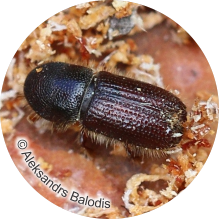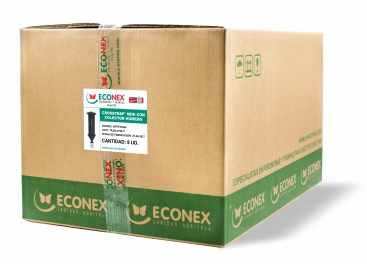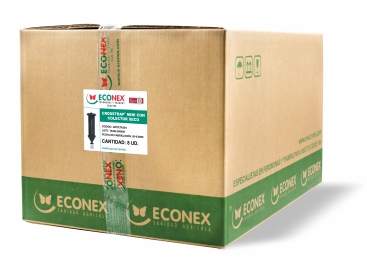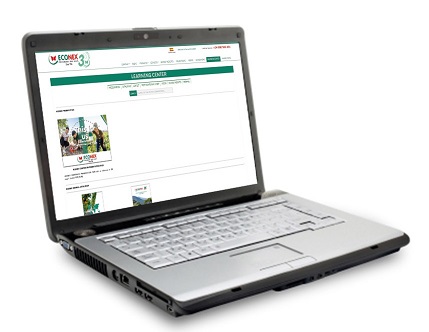General information
The genus Ips is composed of 36 species that are distributed throughout North America, Europe and Asia. This genus has been introduced into Australia and Africa (Faccoli 2004, Cognato & Sun 2007) and 14 species have spread throughout the Palearctic region (Knizek 2011).
Some of the most invasive species of bark beetles belong to the Ips species. Four species can be found on the Iberian Peninsula, including Ips sexdentatus, which is the largest bark beetle of all European fauna.
This species is sometimes considered aggressive, as it is capable of killing trees in their initial stages of decline, such as Pinus sylvestris, P. radiata, P. nigra and P. pinaster species. Pseudotsuga menziesii and some species of Abies, Picea, Cedrus and Larix have also been cited.
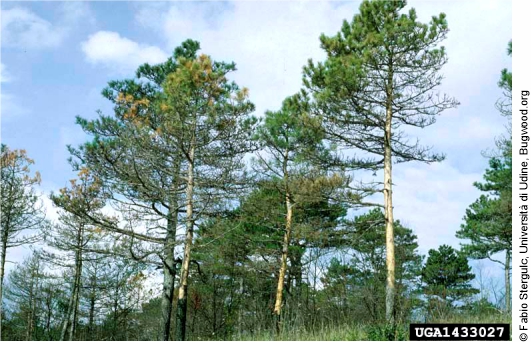
Pine trees attacked by Ips sexdentatus, which show green crowns together with debarked trunks
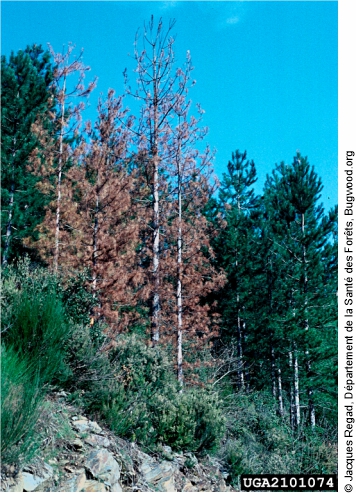
Pine trees killed by attacks from Ips sexdentatus
Morphology and biology
This insect produces three generations a year. The females lay their eggs during two or three consecutive terms in every generation, producing several sibling generations.
It is a polygamous species in which the male is pioneer in the colonisation, by boring a hole in the trunk that leads to a chamber where mating takes place (nuptial chamber).
On average, four females enter into each nuptial chamber. After mating, each female excavates a maternal gallery to lay their eggs on both sides. They can lay from 10 to 60 eggs.
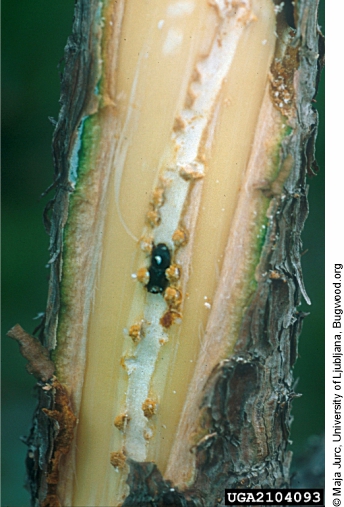
Female laying eggs on both sides of the gallery
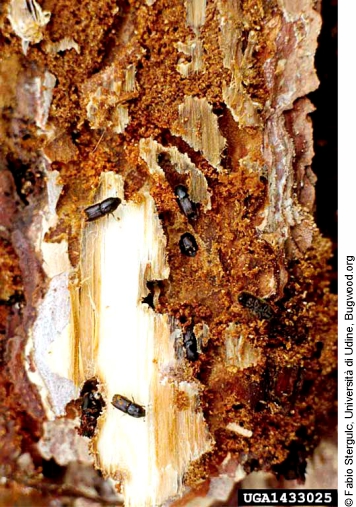
Ips sexdentatusadults
At the beginning of May, the young adults and nymphs of the first generation can already be observed. When they reach their sexual maturity, they begin looking for new places to lay their eggs. In this way, the second and third generations take place and develop throughout the summer.
The first flight period can last for up to two months, therefore the insect can lay eggs up to three times. This means that various sibling generations are produced, so that larvae and imagoes can be found all year round.
The beginning of the flight period and the number of generations can vary from year to year depending on the temperature. In years with favourable conditions for the insects’ development, a fourth generation can be produced although the population level tends to be lower.
The minimum period of time for an egg to reach adulthood is four weeks, which takes place between mid-July and mid-August.
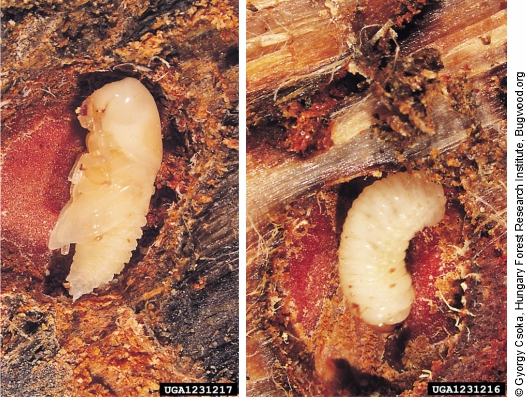
Pupa and larva
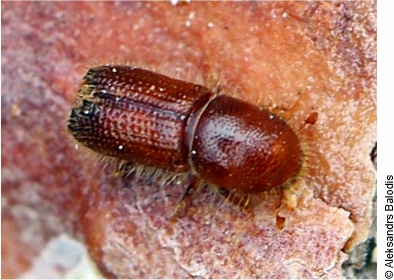
Adult
Damages and elements of diagnosis
Ips sexdentatus snormally behaves as a nonaggressive species, attacking recently deceased trees, such as newly chopped down trees; or very damaged trees, for example by fire.
Sometimes, it can act as an aggressive species, attacking trees that seem to be healthy but with some signs of decline.
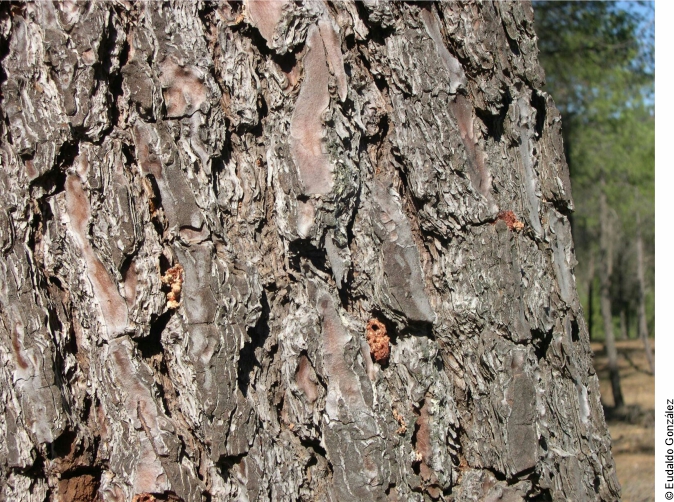
Volcanoes of resin
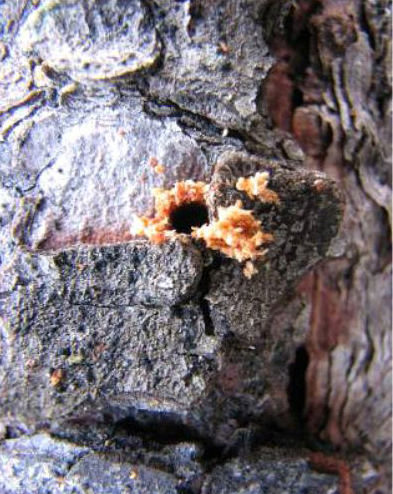
Entry hole made by Ips sexdentatus
The attacked trees are not easily recognised, except for the sawdust accumulations removed from the galleries that can be observed in some trees. Sometimes, volcanoes of resin appear in fairly healthy trees. When the destruction of the phloem is very advanced, the crowns of the trees begin to turn yellow, becoming easily recognisable amongst the trees that have not been attacked.
This species can also vectorise blue Sapstain fungus such as Ophiostoma or Leptographium (Kirisitis 2004), or other pathogens like Ophiostoma minus and O. ips (Romón et al 2007).
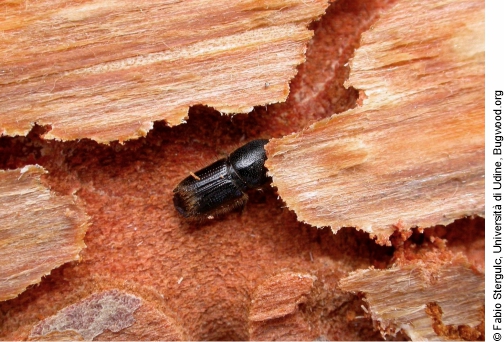
Ips sexdentatus adults inside a gallery
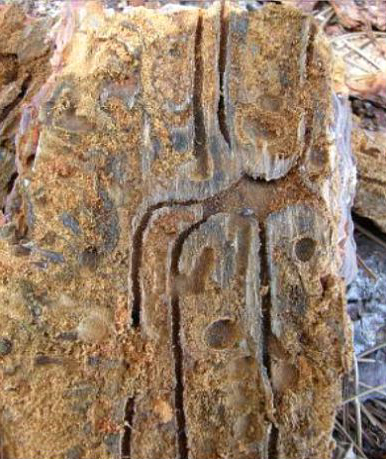
Typical galleries under the bark of a pine tree
Detection and monitoring
In forests CROSSTRAP® MINI should be placed every 20 ha, separated at least 1000 m from each other. In areas less than 20 ha, at least one trap should be placed per stand or forest.
PIn order to surround small circular areas or protect wood stockpiles, use 3 to 10 traps surrounding the area. The traps should be placed in areas with good visibility, such as forest borders, forest trails or fire-breaks. Windy places should be avoided, as the wind complicates the insects’ flight and could damage the traps.
A detection trap system should cover the environmental variability of the monitored forest. As a rule, traps should be placed and active between mid-March and mid-November.
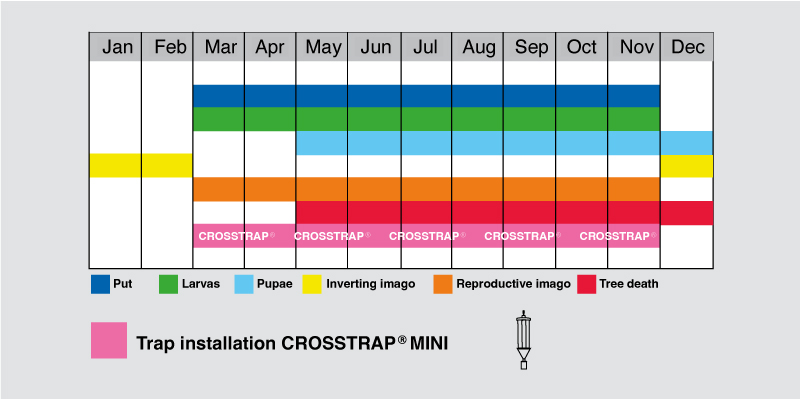
Phenology of Ips sexdentatus
Exhaustive monitoring
For exhaustive monitoring, the traps should be placed between 100 and 500 metres apart from each other in forest trails, forest borders or fire-breaks.
This means a density of 0.3 to 3 CROSSTRAP® MINI traps per ha. They can also be placed inside the forest, as long as it is not too dense. Dry captures are recommended for exhaustive monitoring using the slippery collection cup with a stainless steel mesh on the base.
Necessary material
Una trampa CROSSTRAP® MINIECONEX IPS SEXDENTATUS 3C 60 DAYS (Code: VA294) pheromone diffusers that should be hang on the trap using the lateral holes of the vanes of the trap.
The diffusers are in a blister pack and packaged in an aluminium sachet with label specifications. They last 60 days in field conditions. Once removed from the packaging, the diffusers need no activation or opening, just placed correctly in the trap.
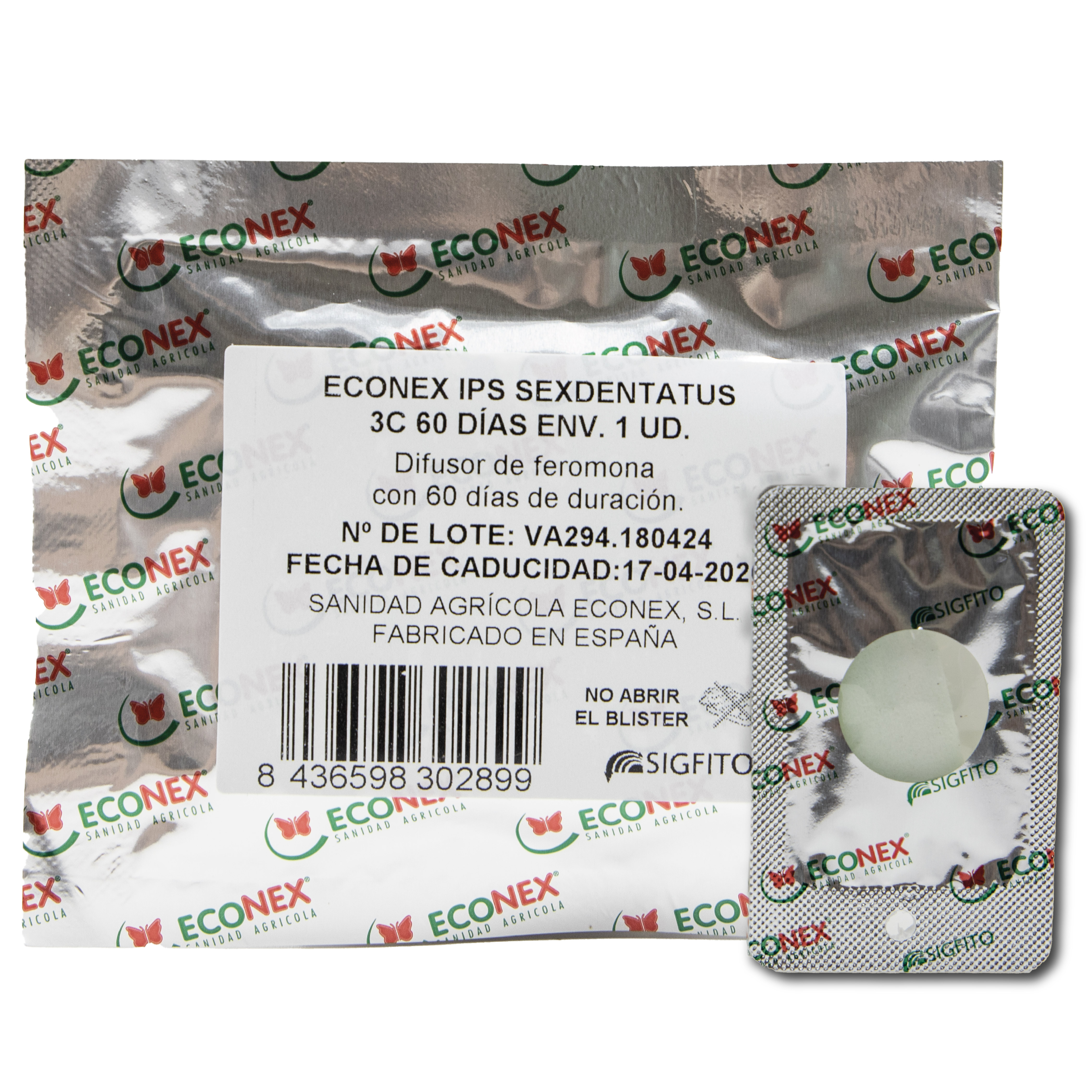
ECONEX IPS
SEXDENTATUS 3C 60 DAYS 1 UNIT
Aggregation pheromone diffusers for the attraction of both sexes of the species Ips sexdentatus, with a duration of 60 days in normal field conditions
Code: UIPHOVA294
OMDF register number (Ministry of Agriculture of Spain): 135/2014

For its correct functioning, it is recommended to use it with the CROSSTRAP® MINI trap, a state-of-the-art trap to catch coleopteran insects during flight. This trap has been developed in an R&D project (University of Murcia - ECONEX) with the aim of developing traps and attractants for forest insects.
These traps consist of a polypropylene lid with a central carabiner attached to a stainless-steel spring and two reinforced PVC sheets anchored at the top to the lid by four stainless steel springs that serve as shock absorbers against strong winds, thus helping to avoid damage to the trap.
At the bottom, the reinforced PVC sheets are attached by steel springs to a removable polypropylene funnel with a 30 cm diameter. At the end of the funnel lies the container for holding the captured insects.
The sheets, the funnel and the collector are treated with a slippery product that considerably increases the catches and prevents them from escaping.
The funnel is made of polypropylene, 30 cm in diameter, and consists of two equal halves that can be easily assembled.
The trap can be operational for up to 10 years, due to its high-strength construction and components. The unfolded trap measures 33 cm in diameter by 106 cm in height.
The trap can be used with two types of collector: CROSSTRAP® WET COLLECTION CUP (with slider) 1L for wet catches, and CROSSTRAP® DRY COLLECTION CUP (with slider) for dry use or live catches.
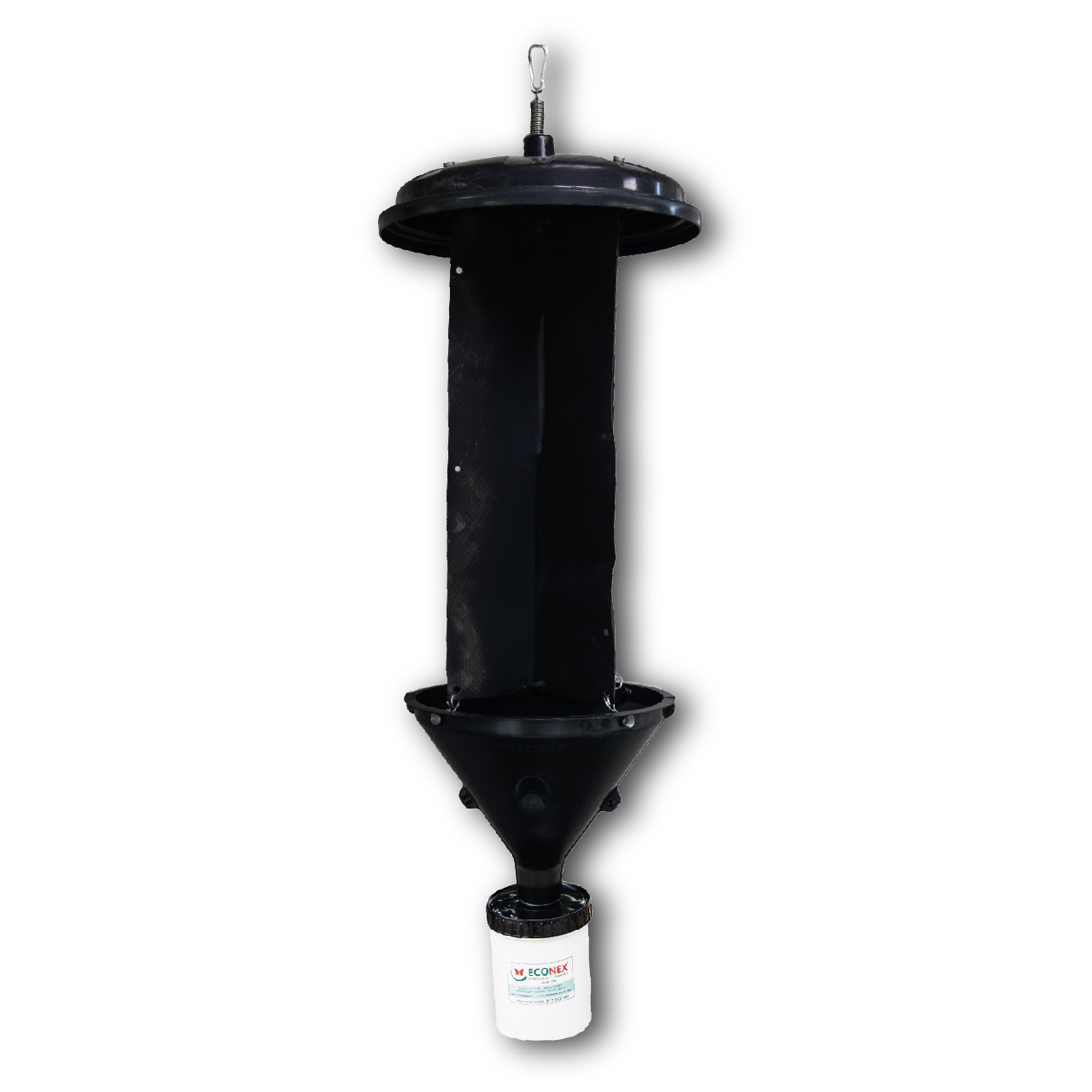
CROSSTRAP® MINI WITH WET COLLECTION CUP (with slider)
Trap for coleopteran insect interception during flight.
Code: UIPFETA226
OMDF register number (Ministry of Agriculture of Spain): 153/2013

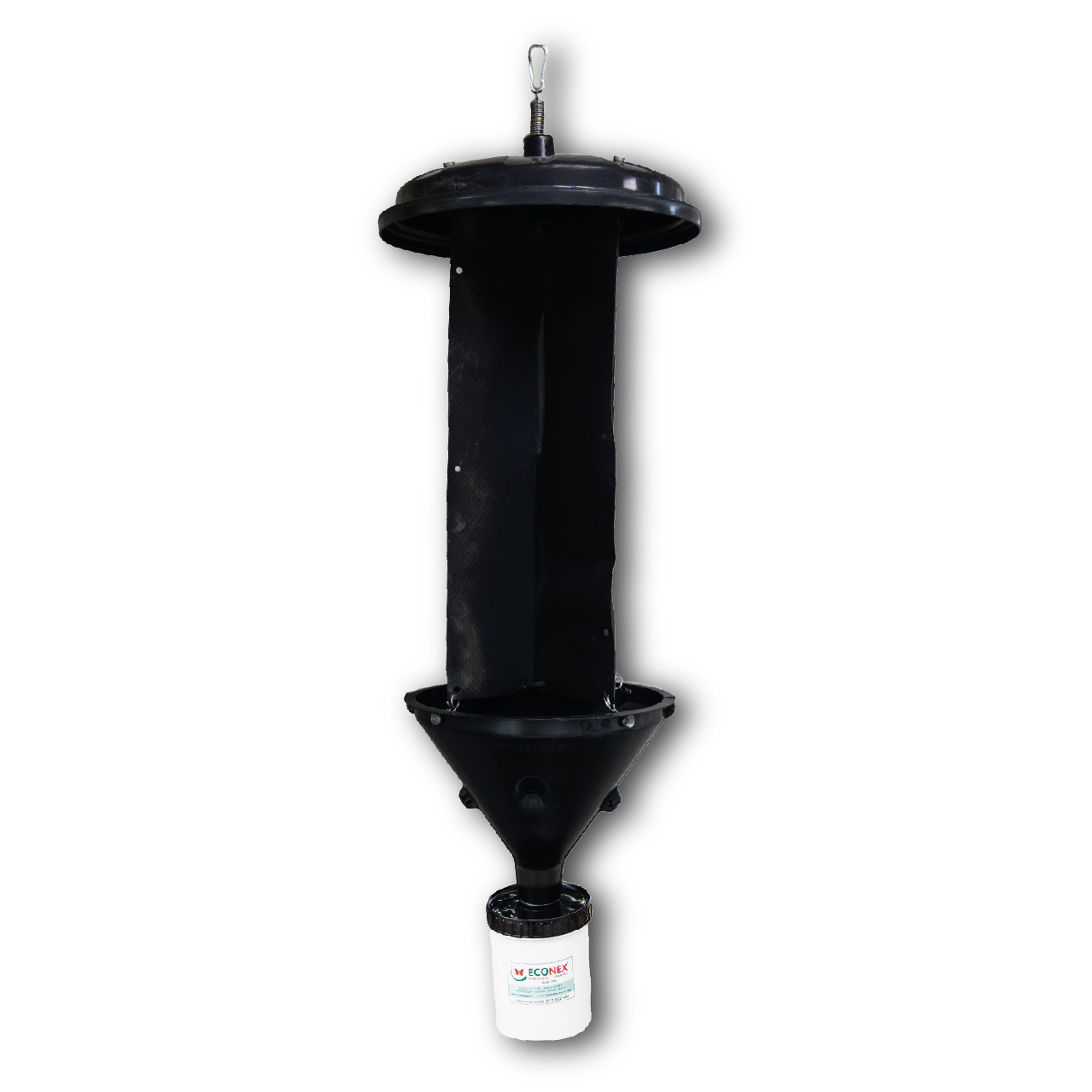
CROSSTRAP® MINI WITH DRY COLLECTION CUP (with slider)
Trap for coleopteran insect interception during flight.
Code: UIPFETA204
OMDF register number (Ministry of Agriculture of Spain): 153/2013

The CROSSTRAP® WET COLLECTION CUP (with slider) 1 L for retaining captured insects is located at the bottom of the funnel. It has a capacity of approximately 1 litre (11 cm diameter x 13.5 cm high).
The CROSSTRAP® DRY COLLECTION CUP (with slider) is designed to hold the captured insects is located at the bottom of the funnel. It has a capacity of approximately 1 litre (11 cm diameter x 13.5 cm high) and is fitted with a stainless-steel mesh at the bottom to allow rainwater to drain away.
Wet catches allow precise identification of the captures. For this purpose, it is recommended to fill the collector with 10 ml of 10 or 20 % diluted propylene glycol or, if necessary, car antifreeze. This liquid serves both as a kill agent and as a preservative, as long as it is not diluted too much by rain, in which case it should be replaced.
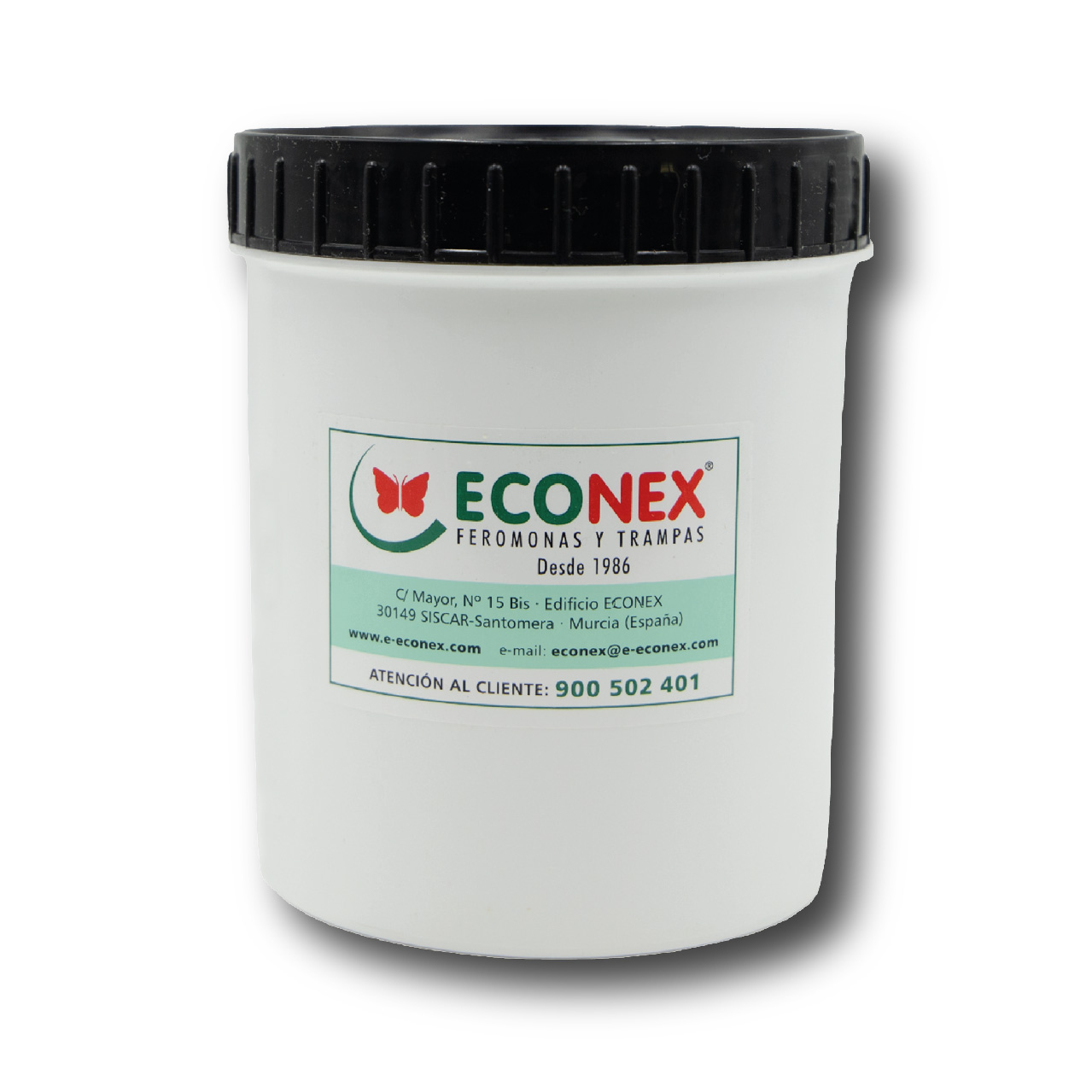
CROSSTRAP® WET COLLECTION CUP (with slider) 1 L
Wet catch collector located at the bottom of CROSSTRAP® traps.
Code: UIPFETA311


CROSSTRAP® DRY COLLECTION CUP (with slider)
Trap collector for dry use, or live traps, located at the bottom of the CROSSTRAP® traps.
Code: UIPFETA157

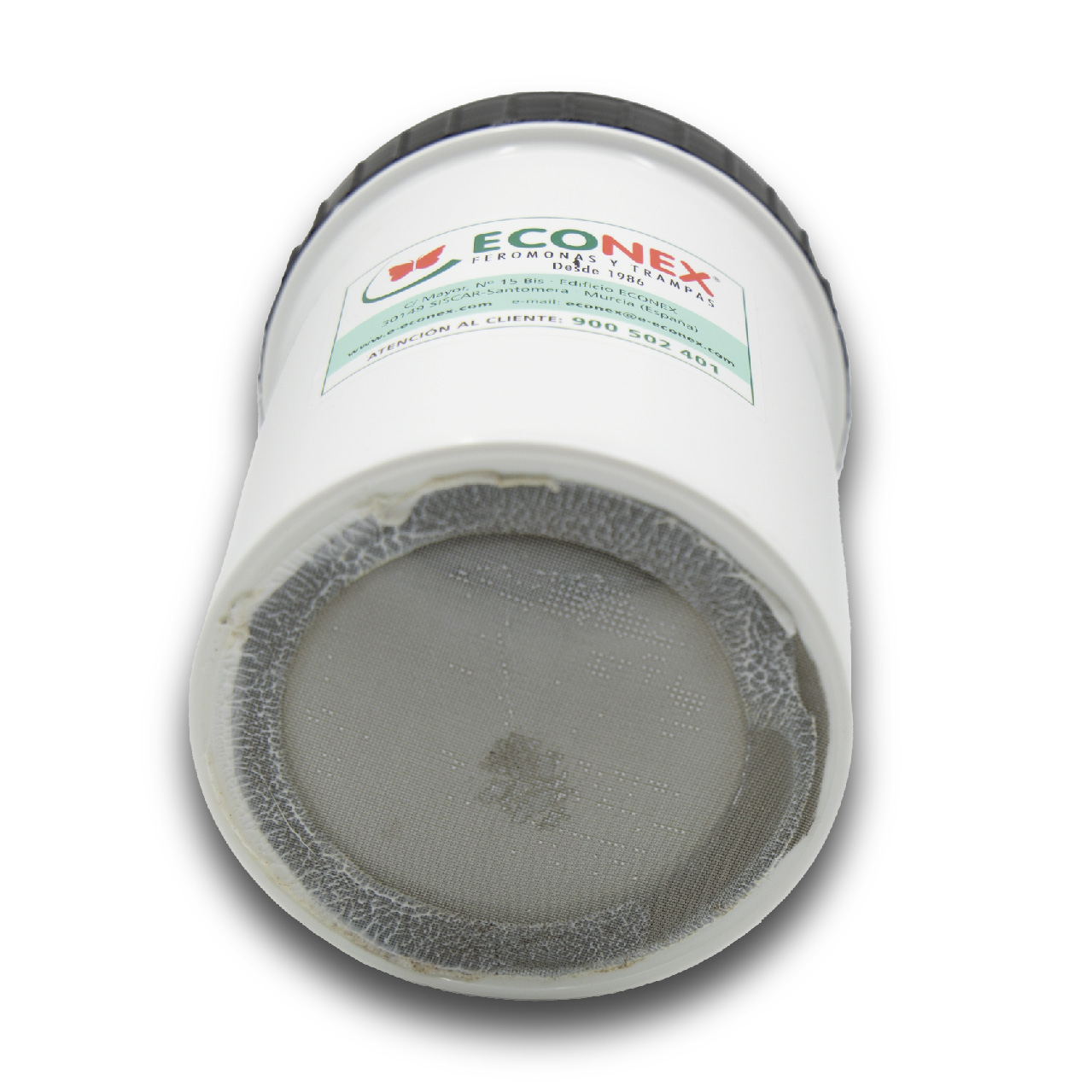
CROSSTRAP® DRY COLLECTION CUP
View from below
Storing the diffurser
The diffusers must be stored in their original packaging in a cool and dry place and separated from food and drinks.
To preserve the diffusers for long periods of time, it is recommended to keep them in the refrigerator at 4 o C in which case they will last for 2 years. Or they can be kept in the freezer at -20 o C for 4 years.
Diffuser packaging
ECONEX IPS SEXDENTATUS 3C 60 DAYS
Corrugated cardboard box of 150 units (30 packs of 5 units).
Box size: 0,60 x 0,40 x 0,35 m (length x width x height).
Box weight: 16.40 kg.
No. of boxes per pallet: 20
Pallet size: 0.80 x 0.120 x 0.2 m (length x width x height).
Pallet weight: 335 kg.
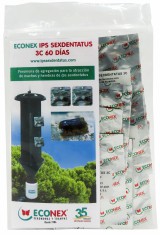
Packs of 5 units.
It includes an information leaflet about product use.
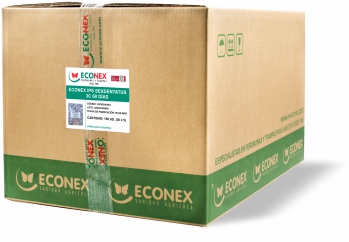
Box of 150 units.
(30 packs x 5 units)
